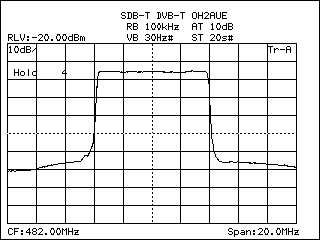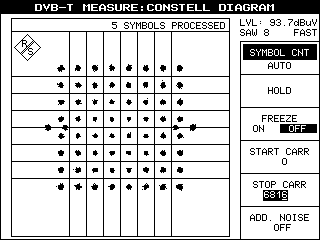

Reworking an old R&S SDB-M DVB-T
modulator:
Return to
OH2AUE homepage
- this DVB-T COFDM
modulator was one of the very first commercially available units
- the unit was junked
by
the former user - it is pretty battered and well, it is a bit out of
date too...
- I am hoping to get
it
working reliably enough for Ham Radio experimenting
- wouldn't it be cool
to
have our Annual OH Ham Radio Camp on air on TV in addition to our
regular FM and AM services ?
- screen shot (103k) of the
box
with a Windows 95 control PC after getting some initial life into the
unit
- a screen shot of the
old
control software COFDM (481k)
configuration
screen
- a screenshot of the RF settings (481k) screen (the
synthesizer is
now running again and locks reliably from 47 MHz to 860 MHz)
- screenshot of the input setting 481k) screen (only parallel
LVDS
available in this unit)
- there is also a test screen (481k) for analysis and
debugging
- just about ideal for
driving any sufficiently linear tranverter for the microwave bands :-)
- a spectrum analyser (73k) plot of
the
COFDM spectrum showing excellent shoulder levels
- need to next take a
look at my DVB-S transmitter - maybe the easiest
thing to do is level translate the TTL level TS stream to LVDS...
- an old article on this
COFDM modulator can be found here (630k)
Final tests of the SDB-M DVB-T
exciter:
- finally got the
opportunity to loan a parallel ASI TS source (the Rohde & Schwarz
DVRG generator) for testing the ancient SDB-M modulator.
- the first vital
signs of things looking good are the red TS
Input Fail changing to green OK in the SDB-M Windows 95 GUI software
- same in the Mode
Screen
- and the IF/RF
Setting Screen
- the Test
Screen ditto
- also had a Rohde &
Schwarz EFA DVB-T/H test receiver at hand, so checked the Constellation
to start with
- of course the parallel
ASI transport stream data is error-free, coming from a reference
generator as can be seen from the MPEG-2 Program
Information Display
- as you can see, there
are three MPEG-2 streams at 6 Mbit/s, 4 Mbit/s and 3 Mbit/s including
Audio and Stuffing in the total of 22.117647 Mbit/s
- the Impulse
Response was absolutely clean, as it should do in these ideal
conditions
- IQ
components in the frequency domain correspond to the constellation
results too
- at the exciter level
of -10 dBm, the RF
spectrum power distribution is still pretty excellent with a Crest
Factor of over 15 dB
- basically the OFDM
modulation parameters are as good as could be expected for a
laboratory grade modulator
- regarding the Modulation
Spectrum, the linearity at this stage (!) is very good with the
shoulders way down at -44 dBc
- Modulation
Error Ratio as a function of carrier is pretty good too, very
workable indeed, averaging at about 35 dB
- channel linearity can
be characterized by traditional Amplitude
Response and Group Delay calculated by FFT from the modulation
spectrum
- Group Delay is really
only the frequency differentiation of Phase
Response, so it indicates the same stuff in a different way
- also loads of
information of the COFDM carrier Modulation
and Bit Error Ratio and also the Modulation Code Rate itself
Transport stream analysis and long
term testing
- using anR&S EFA
for demodulation and a R&S DVB400 for Transport Stream generation
& TS analysis, the SDB-M is working perfectely here too
- ran the SDB-M for
several days at 22.117647 Mbit/s TS rate with 2, 4 and 6 Mbit/s
payloads, 64-QAM, 1/8 Guard Interval, 2/3 FEC, 8k FFT at 434 MHz (!)
- a short video
clip (note: 1.3 Mbyte) running a test stream from the DVB400
Return to
OH2AUE
main page
Established 06.04.2006
Updated 30.06.2006
Updated 30.12.2006
Updated 13.01.2019

